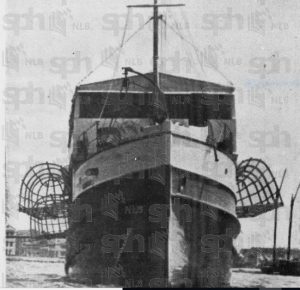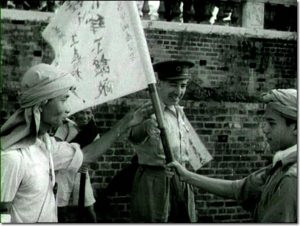- Author
- Editorial Staff
- Subjects
- Ship histories and stories, WWII operations, History - WW2
- Tags
-
- RAN Ships
- None noted.
- Publication
- September 2019 edition of the Naval Historical Review (all rights reserved)
The June 2019 edition of this magazine contained an article The Naval Evacuation of Singapore – February 1942 which lists MV Kembong amongst forty-five vessels that escaped. Her captain is unknown and she sailed with 4 crew and 25 passengers. Since then further interesting information has come to light.
MV Kembong1 was a 1936 vintage Straits Settlements Government Fisheries Research vessel anchored off Singapore in February 1942, out of commission, with her crew dispersed. The lower deck was taken up with refrigeration equipment and brine tanks. She was known locally as ‘The Ice-Box’, therefore in taking passengers she was of limited value, only able to use the upper deck. This reduced the number she could carry to about 25 plus five crew. The ship was powered by temperamental German diesel engines, their operation needing specialist engineering knowledge.
At noon on Sunday 15 February 1942 Lieutenant Colonel Patrick McKerron met with his sister and brother-in-law, Charles Vlieland, who was Secretary for Defence, Malaya, regarding the imminent surrender of the garrison. This was intended to take place at 4 pm but delayed until just after 5 pm when the General Officer Commanding Malaya, Lieutenant General Arthur Percival, made the largest surrender in British military history, consigning the forces under his command to cease hostilities in an unconditional surrender to Lieutenant General Tomoyuki Yamashitu, commanding the Japanese 25th Army. Taking effect from 8.30 pm, control of this mighty fortress and its garrison was handed over to the Imperial Japanese Army.
In the early afternoon McKerron and the Vlielands were joined by an old friend, Commander C. P. Robinson, the Deputy Master Attendant (Deputy Harbour Master). Having decided to face the inevitable with a last bottle of bubbly, they were interrupted by some Dalforce officers2. The Dalforce irregulars, also known as Dalley’s Desperadoes, were mainly local businessmen with some limited military service. As of 13 February they had been told to disband and form an underground guerilla force to escape Japanese reprisals. These Dalforce officers were keen to attempt an escape to Sumatra where they might reform.
While the harbor was alive with troops trying to find anything that would float in which to make their escape all seaworthy craft had long gone. However, Robinson was aware of the derelict Kembong. This gave rise to great excitement with the Army men sensing salvation just over the horizon. Assisted by Dalforce volunteers, McKerron went to find a retired Royal Naval officer, Lieutenant Commander Geoffrey Whitaker3, who was persuaded to take command; that Whitaker was not a navigator but an electrical engineer seemed of little consequence. Two municipal engineers (James Reid, plus another, name unknown), who had some knowledge of diesel engines, were also found. The rest of the crew, with little seafaring experience, were from Dalforce.

By 5 pm a scratch crew and passengers, which now included LTCOL McKerron, had been assembled, totaling about 30 men. Because of the dangers no women were to be taken onboard. A younger and energetic Dalforce officer, Wyatt Smith, commandeered a small motor boat to ferry them to Kembong. This boat was badly holed and with constant bailing could only accommodate four passengers at a time. It therefore took some while to get everyone onboard and after the final trip the motor boat sank. A little after 7.30 pm Kembong’s engines were coaxed into life and at 8 pm the anchor was raised. Against all odds, and crammed like sardines, they were underway. They were witnessing the beginning of the end of the British Empire with the whole city lying under a pall of smoke, lit up by the glow of fires, as the once rich and powerful garrison surrendered to the Japanese. Singapore was no more, it would now be renamed Syonan-To or Light of the South.
With copies of charts supplied by CMDR Robinson they picked their course past minefields but suddenly, late at night when navigating reefs, they went aground. No amount of toing and froing with the engines would shake her free and with a falling tide they were stuck fast. At dawn an island could be seen with Malay fishermen who came to help, and with a rising tide they were once again afloat and, seemingly with little damage, again underway.
While they were overflown by enemy aircraft, who possibly had other things on their minds celebrating their great victory, the small craft was unmolested. Later that day as they were passing close to and masked by the Karim Islands a Japanese destroyer was sighted. Kembong stopped and luckily remained undiscovered.
The Captain anchored near the mouth of the Siak River, a large estuary on the east coast of Sumatra, where she was sheltered from prying eyes. Here there was a small Dutch Customs Station who advised them to proceed about 12 hours up river to Pekanbaru where there was an RAF Base. Meanwhile two small naval launches arrived full of miscellaneous Army and Navy personnel. With the aid of a Dutch pilot they then followed Kembong in convoy. Arrival at the RAF Base was timely as with enemy advances it was due to be evacuated with personnel and aircraft transferred to Java. The RAF provided meals and then loaded their guests onto three buses which took them to the nearest railhead. From here they were taken to Padang on the west coast of Sumatra. The faithful old Kembong and her attendant naval launches were left to the Dutch authorities.
On reaching Padang on Wednesday 18 February they joined similar parties that had been arriving over the past few days. The next day the cruiser HMS Danae arrived from Batavia and took onboard about 80 officers and 500 men. Danae offloaded them at Tjilatjap, a small port now crowded with ships, on the south coast of Java. Arrival was on Sunday 22 February; while this was only a week after leaving Singapore, it felt like a lifetime.
Here another bit of luck came the way of the Dalforce party as they heard of another abandoned ship in need of their newfound recovery skills. SS Perak, a 1,200-ton passenger/cargo steamer of the Straits Steamship Company, had sailed from Singapore a few days before the surrender with personnel from No 36 Squadron RAF embarked. This old steamer, built in 1906, was now lying abandoned in Tandjong Priok, her native crew having deserted. Now with a critical shortage of vessels volunteers were called for to see if Perak could be readied to make another voyage.
Having demonstrated their abilities as matelots many of the ex-Kembong crew were offered berths and were part of about 50 men and a dozen women and children taken aboard. The men were detailed to help the undermanned crew and the women assisted in the galley and saloon. Within hours, with a small naval escort Perak was amongst the last Allied ships to sail from Batavia. Their greatest challenge was transiting the Sunda Strait, now controlled by the Japanese, but somehow hugging the coast they remained undetected. At last the small convoy was in the open sea and made for the west coast of Australia, but Perak stoically continued alone for Colombo, reaching this destination safely on 4 March 1942. While we do not have a crew and passenger list, LTCOL McKerron and LCDR Whitaker were both serving in Colombo in 1942 and it is assumed they arrived in Perak.

No more is known of the fate of Kembong but with a new lease of life the venerable Perak sailed for the Mediterranean. In Haifa she was converted to a hospital ship and later served in the Burma campaign before being returned to her owners in 1945. She was later sold to Chinese shipping interests.
References:
Blackburn, Kevin & Chew Ju Eru, Daniel, Dalforce at the Fall of Singapore in 1942: An Overseas Chinese Heroic Legend, Journal of Chinese Overseas 1, 2 (Nov 2005), NUS Press, Singapore.
Burroughs, Walter, The Naval Evacuation of Singapore – February 1942, Naval Historical Review Vol 40 No 2, June 2019, Naval Historical Society of Australia, Sydney.
McKerron, P.A.B., Escape from Singapore – Dalforce, Journals 65-67 of the Overseas Services Pensioners’ Association (OSPA) April 1993 – April 1994, London.
Malaya Tribune: Colombo Man as Deputy Master Attendant, 24 November 1936.
Straits Times: Malaya’s Fishery Ice-Box, 28 July 1937.
Navy List – December 1941, Admiralty, London.
Singapore in World War II, National Heritage Board, Singapore, 2011.
Notes:
- MV Kembong: little is known about this vessel other than an article appearing in the Straits Times dated 28 July 1937. She appears to be a new acquisition costing £36,000, about £2.5 m in 2019 prices, with a crew of 14 (assumed to be mostly scientific staff).
- Dalforce, formally the Singapore Overseas Chinese Anti-Japanese Volunteer Army, was formed in Singapore in early 1942 by Colonel John Dalley. It comprised about 2,000 Chinese under (mainly retired) British reserve officers, and was only in existence for a matter of weeks. A company from Dalforce fought alongside the 22nd Australian Brigade.
- In February 1942 Geoffrey Charles Whitaker was a retired RN officer on the Emergency List living in Singapore. Revitalising his naval career, from MV Kembong he most likely joined SS Perak, as he is shown serving in Colombo from mid-1942. Post war he was lent to the RAN as Director of the Naval Electrical Branch and later served in the Admiralty at Bath where he retired as a Captain in 1959.




